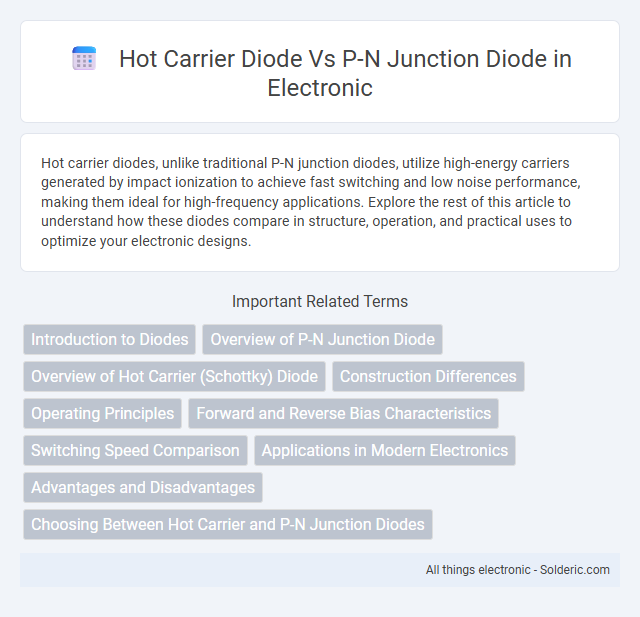Hot carrier diodes, unlike traditional P-N junction diodes, utilize high-energy carriers generated by impact ionization to achieve fast switching and low noise performance, making them ideal for high-frequency applications. Explore the rest of this article to understand how these diodes compare in structure, operation, and practical uses to optimize your electronic designs.
Comparison Table
| Feature | Hot Carrier Diode | P-N Junction Diode |
|---|---|---|
| Definition | Diode utilizing hot carriers generated by high electric fields | Diode formed by joining p-type and n-type semiconductors |
| Operating Principle | Electron transport via high-energy carriers (hot carriers) | Electron-hole recombination at the p-n junction |
| Material | Typically wide bandgap semiconductors | Silicon or other common semiconductors |
| Switching Speed | High-speed operation due to hot carrier effect | Moderate switching speed |
| Applications | High-frequency and microwave devices | Rectification, signal demodulation, general electronics |
| Forward Voltage Drop | Generally higher due to hot carrier energy | Typically 0.7 V for silicon diodes |
| Noise Level | Lower noise in high-frequency applications | Higher noise comparatively |
Introduction to Diodes
Hot carrier diodes leverage high-energy carriers to facilitate faster switching speeds and improved performance in high-frequency applications, contrasting with P-N junction diodes that rely on the traditional diffusion of charge carriers across a semiconductor junction. The P-N junction diode is a fundamental semiconductor device formed by joining p-type and n-type materials, creating a depletion region that controls current flow primarily through carrier recombination and drift mechanisms. Hot carrier diodes exploit ballistic transport phenomena for enhanced operation in advanced circuits, making them suitable for high-speed and high-frequency electronics compared to conventional P-N junction diodes.
Overview of P-N Junction Diode
The P-N junction diode is a fundamental semiconductor device formed by joining p-type and n-type materials, creating a depletion region that allows current to flow primarily in one direction. This diode efficiently controls electrical current, making it essential in rectification, signal modulation, and switching applications. Your understanding of P-N junction diodes is crucial before exploring hotspots carriers, as the junction's behavior under voltage influences how hot carriers generate and affect device performance.
Overview of Hot Carrier (Schottky) Diode
Hot carrier diodes, commonly known as Schottky diodes, feature a metal-semiconductor junction that enables faster switching speeds and lower forward voltage drop compared to traditional P-N junction diodes. These diodes exhibit minimal charge storage, resulting in reduced switching losses and higher efficiency in high-frequency applications such as RF circuits and power rectification. Their unique conduction mechanism, based on majority carriers, allows superior performance in low voltage, high-speed environments relative to conventional silicon-based P-N junction diodes.
Construction Differences
Hot carrier diodes utilize a metal-semiconductor junction, often incorporating materials like silicon carbide, enabling faster switching and higher temperature operation compared to traditional P-N junction diodes. P-N junction diodes consist of a semiconductor crystal with p-type and n-type regions formed by doping, creating a depletion region responsible for rectification. The metal-semiconductor interface in hot carrier diodes reduces carrier recombination, enhancing performance in high-frequency and high-power applications.
Operating Principles
Hot carrier diodes operate based on the principle of hot electron injection, where charge carriers gain sufficient energy to overcome potential barriers, enabling faster switching speeds and higher frequency operation. P-N junction diodes function through the formation of a depletion region at the interface of p-type and n-type semiconductors, allowing current flow predominantly in one direction due to the movement of majority carriers. The distinct energy dynamics in hot carrier diodes enhance performance in RF and microwave applications compared to the standard diffusion and drift mechanisms of P-N junction diodes.
Forward and Reverse Bias Characteristics
Hot carrier diodes exhibit faster switching speeds and reduced forward voltage drop compared to P-N junction diodes due to the high-energy carriers contributing to current conduction. Under forward bias, hot carrier diodes enable rapid charge carrier injection with minimal recombination, enhancing efficiency in high-frequency applications. In reverse bias, their leakage current is typically lower than that of standard P-N junction diodes, resulting in better performance for your circuits requiring low reverse leakage.
Switching Speed Comparison
Hot carrier diodes exhibit significantly faster switching speeds compared to standard P-N junction diodes due to their ability to leverage high-energy carriers for quicker charge transport. While P-N junction diodes rely on slower diffusion processes to switch states, hot carrier diodes minimize transit time and reduce carrier recombination delays. Your choice of diode directly impacts high-frequency circuit performance, making hot carrier diodes ideal for applications requiring rapid response times.
Applications in Modern Electronics
Hot carrier diodes are primarily used in high-frequency and microwave applications due to their fast switching capabilities and low noise performance, making them ideal for signal detection and mixing in RF circuits. P-N junction diodes serve as fundamental components in rectification, voltage regulation, and signal demodulation across a wide range of electronic devices, including power supplies and communication systems. Your choice between these diodes depends on the application's frequency requirements and noise sensitivity within modern electronic systems.
Advantages and Disadvantages
Hot carrier diodes exhibit faster switching speeds and lower forward voltage drops compared to P-N junction diodes, making them ideal for high-frequency applications and low-power losses. However, their manufacturing complexity and higher cost present significant disadvantages compared to the simpler, more robust, and cost-effective P-N junction diodes. P-N junction diodes offer reliable performance in general-purpose rectification but suffer from slower switching speeds and higher forward voltage drop, limiting their efficiency in high-speed circuits.
Choosing Between Hot Carrier and P-N Junction Diodes
Choosing between hot carrier diodes and P-N junction diodes depends on the application's speed and efficiency requirements. Hot carrier diodes offer faster switching and lower forward voltage drop, making them ideal for high-frequency circuits and power conversion. P-N junction diodes provide higher reverse voltage tolerance and better thermal stability, suitable for general-purpose rectification and protection tasks.
Hot carrier diode vs P-N junction diode Infographic

 solderic.com
solderic.com